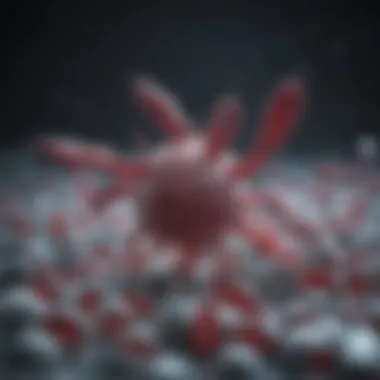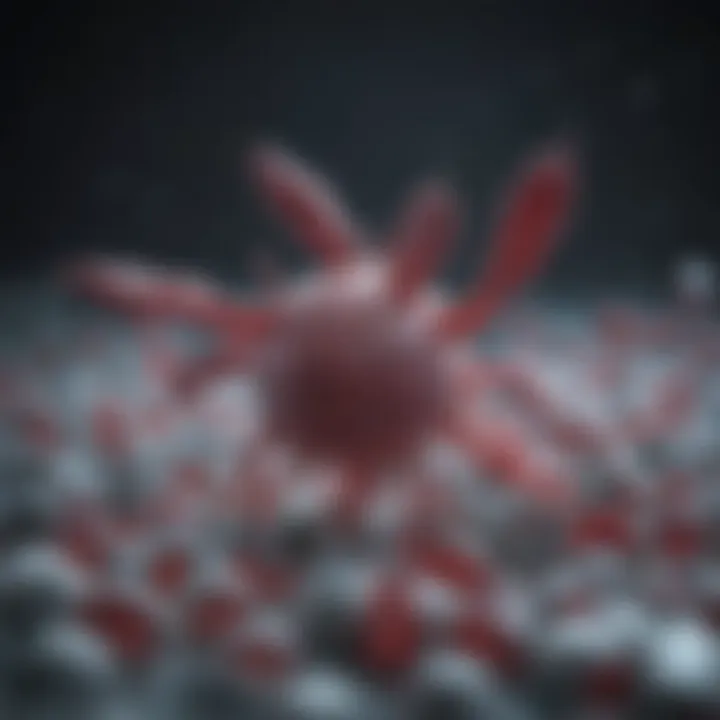Chitin Inhibitors: Mechanisms and Applications


Article Overview
Purpose of the Article
This article aims to provide a detailed examination of chitin inhibitors, focusing on their role in various fields such as agriculture and medicine. It elucidates the mechanisms by which these inhibitors operate, discusses their effectiveness against specific pests and diseases, and highlights any challenges that arise during their development and deployment. The ultimate goal is to offer readers an informed perspective on the significance of chitin inhibitors in biochemistry and applied sciences.
Relevance to Multiple Disciplines
Understanding chitin inhibitors connects several domains, including microbiology, pharmacology, and agricultural science. As researchers explore their biochemical properties, practical applications in pest control and disease management become evident. These inhibitors not only contribute to sustainable agricultural practices but also present possibilities for innovative medical therapies. Thus, their study is pertinent to students, researchers, and professionals across various fields.
Research Background
Historical Context
The study of chitin and its inhibitors began several decades ago. Chitin, a polysaccharide found in the exoskeletons of arthropods and cell walls of fungi, has attracted interest due to its essential role in biological systems. Early research identified the potential of targeting chitin synthase enzymes in pests, leading to the development of chitin inhibitors. Over time, advancements in technology and biochemistry have enabled a deeper understanding of these inhibitors’ mechanisms and broader applications.
Key Concepts and Definitions
Chitin inhibitors primarily work by disrupting the synthesis of chitin, thereby affecting the growth and development of chitin-dependent organisms. Several key terms are critical in this discussion:
- Chitin: A biopolymer forming structural components in arthropods and fungi.
- Chitinase: An enzyme that degrades chitin, playing a role in the lifecycle of pests and pathogens.
- Inhibitor: A substance that slows down or prevents a particular chemical reaction or biological function.
“Chitin inhibitors have the potential to transform our approach to pest management and therapeutic strategies against fungal infections.”
“Chitin inhibitors have the potential to transform our approach to pest management and therapeutic strategies against fungal infections.”
Through a comprehensive overview of the mechanisms, applications, and future research directions of chitin inhibitors, the following sections will reveal their significance in advancing sustainable practices in agriculture and medicine.
Preface to Chitin Inhibitors
Chitin inhibitors are a group of compounds that play a crucial role in various biological processes. They interfere with the synthesis and function of chitin, a structural polysaccharide found in the exoskeletons of arthropods and the cell walls of fungi. The importance of understanding chitin inhibitors lies not only in their applications in agriculture and medicine but also in their potential to address significant global challenges such as pest management and disease control.
Definition and Classification
Chitin inhibitors can be classified based on their source and mechanism of action. They can be derived from natural sources, such as plant extracts or microorganisms, or synthesized in laboratories. The primary classifications include:
- Biochemical inhibitors: These directly affect the enzymes involved in chitin synthesis, such as chitinases.
- Synthetic inhibitors: Man-made compounds that show effectiveness in disrupting chitin production in target organisms.
- Natural chitin inhibitors: Extracts from plants or microbes that have evolved mechanisms to disrupt chitin formation in pests.
Understanding these classifications is vital for researchers and practitioners as it helps in selecting the most suitable based on the specific application needs.
Historical Context
The exploration of chitin inhibitors extends back several decades. Early research focused on the role of chitin in insects and fungi. As scientists understood the importance of chitin, the potential of inhibitors became apparent. In the 1960s, the first successful chitinase enzyme discovery led to increased interest in developing inhibitors that could target such enzymes directly.
By the 1980s, interest in agricultural applications surged, especially as pesticide resistance became a pressing concern. This historical context provides a foundation for understanding how and why chitin inhibitors emerged as a focal point of research in both applied and theoretical biochemistry.
"The future of pest management may depend significantly on the continued development of chitin inhibitors, which offer a unique approach to integrated pest management strategies."
"The future of pest management may depend significantly on the continued development of chitin inhibitors, which offer a unique approach to integrated pest management strategies."
Overall, the introduction of chitin inhibitors reflects a critical area of study with profound implications for sustainability and efficiency in agriculture and medicine.
Biochemical Mechanisms of Action


Understanding the biochemical mechanisms of action of chitin inhibitors is crucial for their effective application in different fields. These mechanisms are at the core of how these substances exert their effects on target organisms, particularly in pest control and medical treatments. By dissecting and analyzing these pathways, researchers can identify potential applications, optimize existing compounds, and foster innovative solutions to combat pests and diseases. The knowledge gained from studying these mechanisms influences agricultural strategies and medical interventions, pushing the boundaries of what is possible with chitin inhibitors.
Targeting Chitin Biosynthesis
Chitin biosynthesis is a fundamental biological pathway in many organisms, most notably in insects and fungi. Chitin forms an essential component of the exoskeleton in arthropods and the cell walls of fungi. Targeting this pathway through chitin inhibitors disrupts the normal growth and development of these organisms.
The action of chitin inhibitors often involves several strategies, including:
- Blocking enzymes: Chitin synthase is an enzyme critical for chitin production. Inhibitors can bind to this enzyme, preventing its function and leading to the failure of chitin formation.
- Disruption of metabolic pathways: By interfering with the metabolic pathways linked to chitin synthesis, chitin inhibitors can adversely affect insect growth and survival.
This targeted approach is especially valuable in pest management, reducing the reliance on traditional pesticides, which may have broader ecological impacts.
Interference with Chitinase Activity
Chitinases are enzymes that break down chitin into smaller units. Interfering with these enzymes can have significant consequences for organisms dependent on chitin for stability. Chitin inhibitors can affect chitinase activity through various mechanisms, which can lead to:
- Accumulation of chitin: Inhibiting chitinases can cause the buildup of chitin in organisms, disrupting their physiological processes and leading to developmental issues or mortality.
- Altered growth patterns: Organisms that cannot effectively degrade chitin may experience stunted growth or malformations, as their ability to mobilize energy and nutrients becomes compromised.
The manipulation of chitinase activity further underscores the potential of chitin inhibitors in both agricultural pest control and in medical applications where fungal infections are present.
Influence on Insect Growth Regulators
Chitin inhibitors also influence insect growth regulators (IGRs), substances that control the growth and development of insects. These regulators often mimic hormones, affecting molting and maturation in insects. Chitin inhibitors can modify the effectiveness of IGRs by:
- Enhancing IGR efficacy: By slowing down or halting the development of chitin structures, chitin inhibitors can make IGRs more effective, leading to higher pest mortality rates.
- Altering hormonal balance: Chitin inhibitors can disrupt the hormonal balance in insects, affecting their normal patterns of growth and reproduction.
Incorporating chitin inhibitors in conjunction with IGRs can improve integrated pest management strategies, making them more sustainable and efficient.
Applications in Agriculture
Chitin inhibitors hold significant promise in agricultural applications. Their potential to manage pests while promoting sustainable practices is a focal point in many contemporary studies. Understanding how these inhibitors function can provide insight into their utility in various agricultural settings. This section delves into several key areas: pest control strategies, sustainability in crop production, and resistance management.
Pest Control Strategies
Pest control is a critical aspect of agriculture, directly influencing crop yield and quality. Chitin inhibitors serve as a powerful tool for managing pests, particularly those with chitinous exoskeletons, such as insects and certain fungi. By targeting the biosynthesis of chitin, these inhibitors disrupt the growth and development of pests.
- Mechanisms of Action: Chitin inhibitors work by blocking the enzymes responsible for chitin synthesis. This interference results in the inability of pests to form an essential component of their shells and tissues. Consequently, they cannot grow or mature effectively.
- Types of Inhibitors: Some common chitin inhibitors include compounds like benzoylureas and thioureas. These substances are effective against various insect pests, leading to reduced populations in agricultural settings.
- Field Trials: Various field trials have shown promising results. For instance, studies utilizing chitin inhibitors often report decreased insect pest populations and increased crop yields. This outcome can lead to a more sustainable approach, minimizing pesticide use and environmental impact.
Sustainability in Crop Production
The modern agricultural landscape demands sustainable practices to address ecological concerns while ensuring food security. Chitin inhibitors can contribute to sustainable crop production in several ways:
- Reduction in Chemical Pesticides: By using chitin inhibitors, farmers may rely less on broad-spectrum chemical pesticides. This shift contributes to lower chemical residues in the environment and food supply.
- Biodiversity Preservation: Targeting specific pests allows beneficial organisms to thrive. This biodiversity is essential for maintaining healthy ecosystems and resilient agricultural systems.
- Soil Health Improvement: The reduced reliance on harmful chemicals can promote better soil health. Squishing down on harmful chemicals improves the microbial environment in the soil, enhancing nutrient cycling and plant growth.
Resistance Management
One significant challenge in pest control is the development of resistance among pest populations. Chitin inhibitors offer potential benefits in managing resistance:
- Mode of Action Diversity: Chitin inhibitors differ in their mechanisms relative to traditional pesticides. This diversity can disrupt resistance development in pest populations, prolonging the effectiveness of pest management strategies.
- Integrated Pest Management (IPM): Incorporating chitin inhibitors into IPM strategies can create a more holistic approach to pest management. Combining various methods can minimize the likelihood of resistance development.
- Monitoring Effectiveness: Ongoing research is crucial to monitoring the effectiveness of chitin inhibitors. Proactive strategies must adapt based on pest response to these compounds, ensuring continued efficacy in pest management.
Chitin inhibitors represent a key advancement in agricultural science, providing targeted solutions for pest control while promoting sustainability and addressing resistance development.
Chitin inhibitors represent a key advancement in agricultural science, providing targeted solutions for pest control while promoting sustainability and addressing resistance development.


Medical Applications of Chitin Inhibitors
The exploration of chitin inhibitors transcends the agricultural domain, extending significantly into medical applications. Their importance lies in their potential to combat various diseases and health conditions. As understanding of chitin biosynthesis and its inhibitors advances, researchers identify unique opportunities that arise. Whether in antifungal treatments or innovative cancer therapies, the versatility of chitin inhibitors is evident. This section dissects the specific medical uses of these compounds and considers their implications for health sciences.
Antifungal and Antibiotic Potential
Chitin inhibitors present a promising strategy in the fight against fungal infections which pose real threats in clinical settings. Fungi form a rigid cell wall primarily made of chitin, a structural polysaccharide. Inhibiting the synthesis of chitin can weaken fungal cells, leading to their demise. Research indicates that compounds such as allosamidin can effectively target the enzymes responsible for chitin biosynthesis, resulting in potent antifungal activity.
Moreover, some studies show that chitinase has synergistic effects when used in conjunction with traditional antibiotics. For instance, combining these inhibitors with commonly prescribed antibiotics could enhance overall effectiveness, particularly against resistant strains of bacteria and fungi.
- Benefits of antifungal chitin inhibitors include:
- Broad-spectrum activity against various fungi.
- Reduction in the risk of resistance development.
- Potential to act in conjunction with existing antibiotics.
Chitin inhibitors can offer new avenues for antifungal treatments, addressing urgent medical needs.
Chitin inhibitors can offer new avenues for antifungal treatments, addressing urgent medical needs.
Role in Cancer Therapy
The role of chitin inhibitors in cancer therapy is an emerging area of research. Certain compounds have shown the ability to inhibit tumor growth and metastasis in preclinical models. The mechanisms involve the modulation of cellular pathways associated with cancer progression. For example, chitinase-like proteins have been implicated in tumor biology, suggesting that inhibiting these proteins could support therapeutic strategies.
Furthermore, the anti-inflammatory properties of chitin inhibitors also provide additional therapeutic angles. Inflammation plays a critical role in various cancer types, and managing immune responses effectively can improve patient outcomes. Hence, chitin inhibitors have the potential to contribute to combination therapies that utilize multiple pathways to fight cancer.
Wound Healing Applications
Chitin inhibitors may also play a significant role in wound healing. Chitin, prevalent in the exoskeletons of insects and crustaceans, exhibits properties that promote tissue regeneration. Studies suggest that chitin-derived materials can enhance the healing process by fostering an environment conducive to cellular migration and proliferation.
In medical applications, formulations that integrate chitin inhibitors can help manage chronic wounds and lesions. They assist not only in controlling infections but also in modulating inflammatory responses in wound areas. Potential applications can be categorized as follows:
- Antimicrobial Dressings: Utilizing chitin derivatives to create dressings that prevent infections while promoting healing.
- Biocompatible Scaffolds: Enhancing tissue engineering efforts by providing structures that support cellular development.
Challenges in Development and Implementation
The topic of challenges in development and implementation of chitin inhibitors is crucial in understanding the broader implications of this field. As research blossoms, various hurdles emerge that can impede progress. These challenges are not just technical but also regulatory and environmental, affecting how chitin inhibitors are used in practice.
Regulatory Hurdles
The regulatory landscape surrounding chitin inhibitors is complex. Each country has its own framework regarding biocontrol agents and other agricultural inputs. For instance, in the United States, the Environmental Protection Agency (EPA) oversees the registration of biopesticides, which includes chitin inhibitors. This process requires substantial data on efficacy and safety, often resulting in lengthy approvals that delay market entry.
Key considerations include:
- Data requirements: Studies must demonstrate not only the effectiveness of the chitin inhibitors but also their safety to non-target organisms, humans, and the environment.
- Cost of compliance: The financial burden associated with extensive testing and documentation can deter smaller companies from investing in this technology.
- Market acceptance: Farmers often hesitate to adopt new biopesticides due to the established use of traditional chemicals and the perceived risk associated with new products.
"Navigating through regulatory hurdles is complex but essential for ensuring the safe and effective use of chitin inhibitors in agriculture."
"Navigating through regulatory hurdles is complex but essential for ensuring the safe and effective use of chitin inhibitors in agriculture."
Environmental Impact Concerns
Environmental impact is another significant concern regarding the use of chitin inhibitors. While they offer advantages such as reduced chemical residues, there are potential environmental interactions that require careful assessment. The following considerations are essential in this context:


- Ecosystem effects: The introduction of new compounds can have unintended consequences on local ecosystems. The impact on non-target species, including beneficial insects, needs to be thoroughly evaluated.
- Development of resistance: Just as with traditional pesticides, the potential for pests to develop resistance to chitin inhibitors is a critical consideration for long-term sustainability. This situation can lead to a cycle of increased application rates or the need for additional management strategies.
- Biodegradability and persistence: Understanding how quickly these inhibitors break down in the environment can inform their safety profile. Persistent compounds pose a risk to soil and water conservation, affecting ecosystems.
Current Research Trends
The exploration of chitin inhibitors is continually evolving. Current research trends highlight the significance of these substances in various fields, particularly in agriculture and medicine. Identifying novel compounds and studying their mechanisms can lead to more effective applications. Researchers aim to harness the benefits of these innovations while addressing existing challenges.
Emerging Technologies
Emerging technologies are playing a crucial role in the advancement of chitin inhibitors. Techniques such as genomics, bioinformatics, and advanced screening methods are paving the way for discovering new chitinase inhibitors. These technologies offer precision in identifying effective compounds and understanding their biochemical impacts.
- Genomic Approaches: New genetic tools enable researchers to manipulate organisms at a molecular level. This may lead to the development of transgenic plants that can resist specific pests through enhanced chitinase inhibition.
- Nanotechnology: The application of nanoparticles in delivering chitin inhibitors shows promise. This can enhance the bioavailability and stability of these compounds, making them more effective in pest control.
- High-Throughput Screening: With advancements in laboratory techniques, high-throughput screening allows for rapid testing of multiple compounds. This accelerates the identification of effective chitin inhibitors.
These technological strides demonstrate a shift towards more efficient and innovative methods in chitin inhibitor research.
Interdisciplinary Approaches
The complexity of chitin inhibitors necessitates an interdisciplinary approach. Collaboration among biologists, chemists, environmental scientists, and agricultural experts can enhance the understanding and application of these inhibitors.
- Cross-Disciplinary Research: Integrating knowledge from various fields fosters innovation. For instance, combined studies in microbiology and plant sciences can lead to the discovery of novel biocontrol agents derived from chitinase-producing organisms.
- Collaborative Studies: Joint research initiatives can involve universities and private sectors. Such partnerships can provide the necessary resources and expertise for large-scale experiments.
- Holistic Solutions: Addressing environmental concerns associated with traditional pesticides requires a broader perspective. Chitin inhibitors present an ecological alternative that might reduce the reliance on synthetic chemicals.
Research trends indicate an emerging focus on collaborative and inclusive methodologies. The future of chitin inhibitor studies relies on these evolving paradigms.
Future Directions in Chitin Inhibitor Research
Research on chitin inhibitors is evolving. Understanding future directions is essential for enhancing their applications. It provides insight into potential advancements in this field. Focusing on the innovations in design and function can lead to better products for agriculture and medicine.
Potential for Novel Compounds
The search for novel chitin inhibitor compounds is critical. New compounds can improve efficacy and reduce resistance in pests and pathogens. Researchers are looking into naturally occurring sources. For instance, certain fungi produce chitinase, which can be harnessed. These natural inhibitors might offer insight into developing synthetic pathways for new compounds. The goal is to create solutions that are more targeted, thus minimizing collateral damage to beneficial organisms.
Additionally, novel compounds can exhibit selectivity. This means they could be effective against specific pests while leaving non-target species unharmed. This selectivity is vital for sustainable agriculture. It ensures that beneficial insects, like bees and ladybugs, are not affected.
In exploring these compounds, it is crucial to conduct thorough screening. Researchers must assess their safety and efficacy. This includes understanding their environmental impact. New compounds will need rigorous testing to meet regulatory standards.
Impact of Genetic Engineering
Genetic engineering offers promising avenues in chitin inhibitor research. Scientists are examining how to modify genes in various organisms to produce chitinase or inhibit chitin synthesis. By altering specific genes, it is possible to create organisms that naturally produce effective chitin inhibitors. This could lead to more sustainable options for pest control.
Genetically modified crops can also play a significant role. For example, plants that express chitinase may deter pests more effectively. This would reduce the need for chemical pesticides. The implications extend beyond agriculture to biotechnology and pharmaceuticals.
However, genetic modifications often face public scrutiny and regulatory challenges. Ethical considerations in genome editing are paramount. Understanding the public perception of genetically engineered organisms is also important when proceeding with this research.
Investing in genetic engineering could reshape the landscape of chitin inhibitors, offering new tools in pest management and health care.
Investing in genetic engineering could reshape the landscape of chitin inhibitors, offering new tools in pest management and health care.
Combining traditional methods with genetic innovation might yield the most beneficial outcomes. Researchers can use both approaches to develop a comprehensive pest control strategy that aligns with environmental sustainability goals.
Closure
The conclusion of this article serves as a critical reflection on the multifaceted nature of chitin inhibitors. This topic is not only significant in understanding the biochemical pathways but also essential in evaluating their broader implications in agriculture and medicine. Chitin inhibitors offer potential advantages in pest management and disease control, providing an alternative to conventional chemical pesticides. This approach aligns well with modern demands for sustainable agricultural practices and the reduction of environmental impact.
Summary of Findings
In summarizing the findings, it is clear that chitin inhibitors play a pivotal role in various applications. The mechanisms of action demonstrate significant interference with chitin biosynthesis and enzymatic activity, leading to effective pest control. Additionally, their contributions to medical applications, particularly in combating fungal infections and promoting wound healing, underline their versatility. Relevant literature supports these findings, emphasizing the need for continued investigation into their efficacy and applications.
Implications for Future Research
The implications for future research on chitin inhibitors are profound. As the agricultural and medical landscapes evolve, there is potential for the development of novel compounds with enhanced efficacy and specificity. Furthermore, advancements in genetic engineering may pave the way for tailored chitin inhibitors that address specific pest or pathogen challenges. The integration of interdisciplinary approaches will likely foster innovation, leading to improved formulations and application techniques that can further optimize the use of chitin inhibitors in real-world scenarios.



